Francis Drake
Sir Francis Drake (c. 1540 – 28 January 1596[3]) was an English sea captain, privateer, naval officer and explorer. Drake is most famously known for his circumnavigation of the world in a single expedition, from 1577 to 1580, and was the first to complete the voyage as captain while leading the expedition throughout the entire circumnavigation. With his incursion into the Pacific Ocean, he claimed what is now California for the English and inaugurated an era of conflict with the Spanish on the western coast of the Americas,[4] an area that had previously been largely unexplored by western shipping.[5]
Sir Francis Drake | |
|---|---|
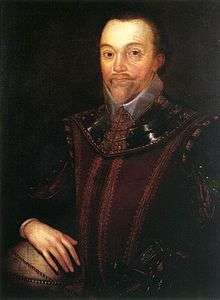 Sir Francis Drake, oil painting by Marcus Gheeraerts the Younger in Buckland Abbey (after 1590) | |
| Born | c. 1540 Tavistock, Devon, England |
| Died | 28 January 1596 (aged 55) Portobelo, Colón, Panama |
| Spouse(s) | Mary Newman
( m. 1569; died 1581)Elizabeth Sydenham ( m. 1585) |
| Piratical career | |
| Nickname | El Draque (Spanish), Draco (Latin, "The Dragon") |
| Type | Privateer |
| Allegiance | Kingdom of England |
| Years active | 1563–1596 |
| Rank | Vice admiral |
| Base of operations | Caribbean Sea |
| Commands | Golden Hind (previously known as Pelican) Bonaventure Revenge |
| Battles/wars | Anglo–Spanish War Battle of Gravelines |
| Wealth | Est. Equiv. US$136.6 million in 2019;[1] #2 Forbes top-earning pirates[2] |
| Signature | |
 | |
Elizabeth I awarded Drake a knighthood in 1581 which he received on the Golden Hind in Deptford. In the same year he was appointed mayor of Plymouth. As a Vice Admiral, he was second-in-command of the English fleet in the victorious battle against the Spanish Armada in 1588. He died of dysentery in January 1596,[6] after unsuccessfully attacking San Juan, Puerto Rico.
Drake's exploits made him a hero to the English, but his privateering led the Spanish to brand him a pirate, known to them as El Draque.[7] King Philip II allegedly offered a reward of 20,000 ducats for his capture or death,[8] about £6 million (US$8 million) in modern currency.[9] Some declare Drake a ‘slave trader’ (see Presentism) due to the fact that, as a young man, Drake served under his cousin Richard Hawkins who led some of the earliest English slaving voyages[10][11] of the Elizabethan era.
Birth and early years
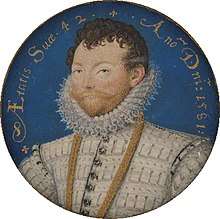
Francis Drake was born in Tavistock, Devon, England. Although his birth date is not formally recorded, it is known that he was born while the Six Articles were in force. His birth date is estimated from contemporary sources such as: "Drake was two and twenty when he obtained the command of the Judith"[12] (1566). This would date his birth to 1544. A date of c. 1540 is suggested from two portraits: one a miniature painted by Nicholas Hilliard in 1581 when he was allegedly 42, so born circa 1539, while the other, painted in 1594 when he was said to be 52,[13] would give a birth year of around 1541. Lady Elliott-Drake, the collateral descendant, and final holder of the Drake Baronetcy, argued in her book on 'The Family and Heirs of Sir Francis Drake' that Drake's birth year was 1541.[14]
He was the oldest of the twelve sons[15] of Edmund Drake (1518–1585), a Protestant farmer, and his wife Mary Mylwaye. The first son was alleged to have been named after his godfather Francis Russell, 2nd Earl of Bedford.[16][17]
Because of religious persecution during the Prayer Book Rebellion in 1549, the Drake family fled from Devon to Kent. There Drake's father obtained an appointment to minister the men in the King's Navy. He was ordained deacon and was made vicar of Upnor Church on the Medway.[18] Drake's father apprenticed him to his neighbour, the master of a barque used for coastal trade transporting merchandise to France.[18] The ship's master was so satisfied with the young Drake's conduct that, being unmarried and childless at his death, he bequeathed the barque to Drake. [18]
Marriage and family
Francis Drake married Mary Newman at St. Budeaux church, Plymouth, in July 1569. She died 12 years later, in 1581. In 1585, Drake married Elizabeth Sydenham—born circa 1562, the only child of Sir George Sydenham, of Combe Sydenham,[19] who was the High Sheriff of Somerset.[20] After Drake's death, the widow Elizabeth eventually married Sir William Courtenay of Powderham.[21]
Career at sea
In the 1550s, Drake’s father found the young man a position with the owner and master of a small barque. Drake likely engaged in commerce among England, the Low Countries and France. On the death of the bark’s owner, Drake was given the bark.[22]
At the age of eighteen he was purser of a ship which sailed to the Bay of Biscay.[23]
At twenty (ca. 1563-1564) he made a voyage to the coast of Guinea in a ship owned by William and John Hawkins, some of his relatives from Plymouth.[24][25][26]
In 1566-1567, Drake, made his first voyage to the Americas, sailing under Captain John Lovell on one of a fleet of ships owned by the Hawkins family. They attacked Portuguese towns and ships on the coast of West Africa and then sailed to the Americas and sold the captured cargoes of slaves to Spanish plantations.[27] The voyage was largely unsuccessful and more than 90 slaves were released without payment.[28][29]
Drake's second voyage to the Americas and his second slaving voyage ended in the ill-fated 1568 incident at San Juan de Ulúa.[30][31][32] Whilst negotiating to resupply and repair at a Spanish port in Mexico, the fleet was attacked by Spanish warships, with all but two of the English ships lost. He escaped along with John Hawkins, surviving the attack by swimming. Drake's hostility towards the Spanish is said to have started with this incident and Drake vowed revenge.[33]
In 1570, his reputation enabled him to proceed to the West Indies with two vessels under his command. He renewed his visit the next year for the sole purpose of obtaining information.[24]
Drake's first victory
In 1572, he embarked on his first major independent enterprise. He planned an attack on the Isthmus of Panama, known to the Spanish as Tierra Firme and the English as the Spanish Main. This was the point at which the silver and gold treasure of Peru had to be landed and sent overland to the Caribbean Sea, where galleons from Spain would pick it up at the town of Nombre de Dios. Drake left Plymouth on 24 May 1572, with a crew of 73 men in two small vessels, the Pascha (70 tons) and the Swan (25 tons), to capture Nombre de Dios.
His first raid was late in July 1572. Drake formed an alliance with the Cimarrons. Drake and his men captured the town and its treasure. When his men noticed that Drake was bleeding profusely from a wound, they insisted on withdrawing to save his life and left the treasure. Drake stayed in the area for almost a year, raiding Spanish shipping and attempting to capture a treasure shipment.
The most celebrated of Drake's adventures along the Spanish Main was his capture of the Spanish Silver Train at Nombre de Dios in March 1573. He raided the waters around Darien (in modern Panama) with a crew including many French privateers including Guillaume Le Testu, a French buccaneer, and African slaves (Maroons) who had escaped the Spanish. One of these men was Diego, who under Drake became a free man was also a capable ship builder.[34] Drake tracked the Silver Train to the nearby port of Nombre de Dios. After their attack on the richly laden mule train, Drake and his party found that they had captured around 20 tons of silver and gold. They buried much of the treasure, as it was too much for their party to carry, and made off with a fortune in gold.[35][36] (An account of this may have given rise to subsequent stories of pirates and buried treasure). Wounded, Le Testu was captured and later beheaded. The small band of adventurers dragged as much gold and silver as they could carry back across some 18 miles of jungle-covered mountains to where they had left the raiding boats. When they got to the coast, the boats were gone. Drake and his men, downhearted, exhausted and hungry, had nowhere to go and the Spanish were not far behind.
At this point, Drake rallied his men, buried the treasure on the beach, and built a raft to sail with two volunteers ten miles along the surf-lashed coast to where they had left the flagship. When Drake finally reached its deck, his men were alarmed at his bedraggled appearance. Fearing the worst, they asked him how the raid had gone. Drake could not resist a joke and teased them by looking downhearted. Then he laughed, pulled a necklace of Spanish gold from around his neck and said "Our voyage is made, lads!" By 9 August 1573, he had returned to Plymouth.
It was during this expedition that he climbed a high tree in the central mountains of the Isthmus of Panama and thus became the first Englishman to see the Pacific Ocean. He remarked as he saw it that he hoped one day an Englishman would be able to sail it – which he would do years later as part of his circumnavigation of the world.[37]
When Drake returned to Plymouth after the raids, the government signed a temporary truce with King Philip II of Spain and so was unable to acknowledge Drake's accomplishment officially. Drake was considered a hero in England and a pirate in Spain for his raids.[38]
Rathlin Island massacre
Drake was present at the Rathlin Island massacre in 1575. Acting on the instructions of Sir Henry Sidney and the Earl of Essex, Sir John Norreys and Drake laid siege to Rathlin Castle. Despite their surrender, Norreys' troops killed all the 200 defenders and more than 400 civilian men, women and children of Clan MacDonnell.[39] Meanwhile, Drake was given the task of preventing any Gaelic Irish or Scottish reinforcements reaching the island. Therefore, the remaining leader of the Gaelic defence against English power, Sorley Boy MacDonnell, was forced to stay on the mainland. Essex wrote in his letter to Queen Elizabeth's secretary, that following the attack Sorley Boy "was likely to have run mad for sorrow, tearing and tormenting himself and saying that he there lost all that he ever had."[40]
Circumnavigation (1577–1580)
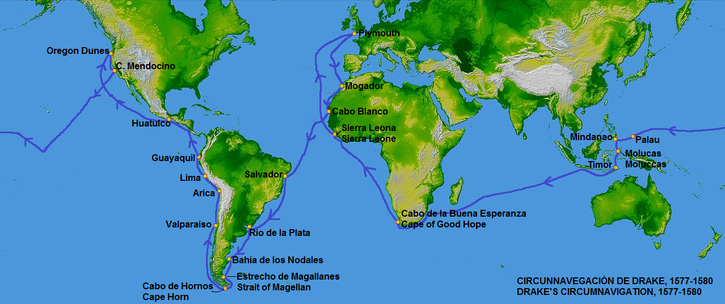
With the success of the Panama isthmus raid in 1577, Elizabeth I of England sent Drake to start an expedition against the Spanish along the Pacific coast of the Americas. Drake used the plans that Sir Richard Grenville had received the patent for in 1574 from Elizabeth, which was rescinded a year later after protests from Philip of Spain. Diego was once again employed under Drake; his fluency in Spanish and English would make him a useful interpreter when Spaniards or Spanish-speaking Portuguese were captured. He was employed as Drake's servant and was paid wages, just like the rest of the crew.[34] Drake and the fleet set out from Plymouth on 15 November 1577, but bad weather threatened him and his fleet. They were forced to take refuge in Falmouth, Cornwall, from where they returned to Plymouth for repair.[41]
After this major setback, Drake set sail again on 13 December aboard Pelican with four other ships and 164 men. He soon added a sixth ship, Mary (formerly Santa Maria), a Portuguese merchant ship that had been captured off the coast of Africa near the Cape Verde Islands. He also added its captain, Nuno da Silva, a man with considerable experience navigating in South American waters.
Drake's fleet suffered great attrition; he scuttled both Christopher and the flyboat Swan due to loss of men on the Atlantic crossing. He made landfall at the gloomy bay of San Julian, in what is now Argentina. Ferdinand Magellan had called here half a century earlier, where he put to death some mutineers. Drake's men saw weathered and bleached skeletons on the grim Spanish gibbets. Following Magellan's example, Drake tried and executed his own "mutineer" Thomas Doughty. The crew discovered that Mary had rotting timbers, so they burned the ship. Drake decided to remain the winter in San Julian before attempting the Strait of Magellan.[42]
Execution of Thomas Doughty
On his voyage to interfere with Spanish treasure fleets, Drake had several quarrels with his co-commander Thomas Doughty and on 3 June 1578, accused him of witchcraft and charged him with mutiny and treason in a shipboard trial.[43] Drake claimed to have a (never presented) commission from the Queen to carry out such acts and denied Doughty a trial in England. The main pieces of evidence against Doughty were the testimony of the ship's carpenter, Edward Bright, who after the trial was promoted to master of the ship Marigold, and Doughty's admission of telling Lord Burghley, a vocal opponent of agitating the Spanish, of the intent of the voyage. Drake consented to his request of Communion and dined with him, of which Francis Fletcher had this strange account:
And after this holy repast, they dined also at the same table together, as cheerfully, in sobriety, as ever in their lives they had done aforetime, each cheering up the other, and taking their leave, by drinking each to other, as if some journey only had been in hand.[44]
Drake had Thomas Doughty beheaded on 2 July 1578. When the ship's chaplain Francis Fletcher in a sermon suggested that the woes of the voyage in January 1580 were connected to the unjust demise of Doughty, Drake chained the clergyman to a hatch cover and pronounced him excommunicated.
Entering the Pacific (1578)
The three remaining ships of his convoy departed for the Magellan Strait at the southern tip of South America. A few weeks later (September 1578) Drake made it to the Pacific, but violent storms destroyed one of the three ships, the Marigold (captained by John Thomas) in the strait and caused another, the Elizabeth captained by John Wynter, to return to England, leaving only the Pelican. After this passage, the Pelican was pushed south and discovered an island that Drake called Elizabeth Island. Drake, like navigators before him, probably reached a latitude of 55°S (according to astronomical data quoted in Hakluyt's The Principall Navigations, Voiages and Discoveries of the English Nation of 1589) along the Chilean coast.[45] In the Magellan Strait Francis and his men engaged in skirmish with local indigenous people, becoming the first Europeans to kill indigenous peoples in southern Patagonia.[46] During the stay in the strait, crew members discovered that an infusion made of the bark of Drimys winteri could be used as remedy against scurvy. Captain Wynter ordered the collection of great amounts of bark – hence the scientific name.[46]
Despite popular lore, it seems unlikely that Drake reached Cape Horn or the eponymous Drake Passage,[45] because his descriptions do not fit the first and his shipmates denied having seen an open sea. Historian Mateo Martinic, who examined his travels, credits Drake with the discovery of the "southern end of the Americas and the oceanic space south of it".[47] The first report of his discovery of an open channel south of Tierra del Fuego was written after the 1618 publication of the voyage of Willem Schouten and Jacob le Maire around Cape Horn in 1616.[48]
Drake pushed onwards in his lone flagship, now renamed the Golden Hind in honour of Sir Christopher Hatton (after his coat of arms). The Golden Hind sailed north along the Pacific coast of South America, attacking Spanish ports and pillaging towns. Some Spanish ships were captured, and Drake used their more accurate charts. Before reaching the coast of Peru, Drake visited Mocha Island, where he was seriously injured by hostile Mapuche. Later he sacked the port of Valparaíso further north in Chile, where he also captured a ship full of Chilean wine.[49]
Capture of Spanish treasure ships
Near Lima, Drake captured a Spanish ship laden with 25,000 pesos of Peruvian gold, amounting in value to 37,000 ducats of Spanish money (about £7m by modern standards). Drake also discovered news of another ship, Nuestra Señora de la Concepción, which was sailing west towards Manila. It would come to be called the Cacafuego. Drake gave chase and eventually captured the treasure ship, which proved his most profitable capture.
Aboard Nuestra Señora de la Concepción, Drake found 36 kilograms (80 lb) of gold, a golden crucifix, jewels, 13 chests full of royals of plate and 26 thousand kilograms (26 long tons) of silver. Drake was naturally pleased at his good luck in capturing the galleon, and he showed it by dining with the captured ship's officers and gentleman passengers. He offloaded his captives a short time later, and gave each one gifts appropriate to their rank, as well as a letter of safe conduct.
Coast of California: Nova Albion (1579)

Prior to Drake's voyage, the western coast of North America had only been partially explored in 1542 by Juan Rodriguez Cabrillo who sailed for Spain.[50] So, intending to avoid further conflict with Spain, Drake navigated northwest of Spanish presence and sought discreet site at which the crew could prepare for the journey back to England.[51][52]
On 5 June 1579, the ship briefly made first landfall at South Cove, Cape Arago, just south of Coos Bay, Oregon, and then sailed south while searching for a suitable harbour to repair his ailing ship.[53][54][55][56][57] On 17 June, Drake and his crew found a protected cove when they landed on the Pacific coast of what is now Northern California.[58][59] While ashore, he claimed the area for Queen Elizabeth I as Nova Albion or New Albion.[60] To document and assert his claim, Drake posted an engraved plate of brass to claim sovereignty for Elizabeth and every successive English monarch.[61] After erecting a fort and tents ashore, the crew labored for several weeks as they prepared for the circumnavigating voyage ahead by careening their ship, Golden Hind, so to effectively clean and repair the hull.[62] Drake had friendly interactions with the Coast Miwok and explored the surrounding land by foot.[63] When his ship was ready for the return voyage, Drake and the crew left New Albion on 23 July and paused his journey the next day when anchoring his ship at the Farallon Islands where the crew hunted seal meat.[64][65][66]
Across the Pacific and around Africa
Drake left the Pacific coast, heading southwest to catch the winds that would carry his ship across the Pacific, and a few months later reached the Moluccas, a group of islands in the western Pacific, in eastern modern-day Indonesia. At this time Diego died from wounds he had sustained earlier in the voyage, Drake was saddened at his death having become a good friend.[34] Golden Hind later became caught on a reef and was almost lost. After the sailors waited three days for convenient tides and had dumped cargo. Befriending Sultan Babullah of Ternate in the Moluccas, Drake and his men became involved in some intrigues with the Portuguese there. He made multiple stops on his way toward the tip of Africa, eventually rounded the Cape of Good Hope, and reached Sierra Leone by 22 July 1580.
Return to Plymouth (1580)
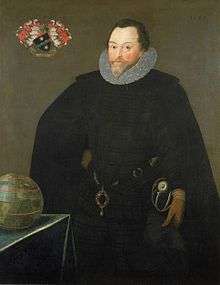
On 26 September, Golden Hind sailed into Plymouth with Drake and 59 remaining crew aboard, along with a rich cargo of spices and captured Spanish treasures. The Queen's half-share of the cargo surpassed the rest of the crown's income for that entire year. Drake was hailed as the first Englishman to circumnavigate the Earth (and the second such voyage arriving with at least one ship intact, after Elcano's in 1520).[68]
The Queen declared that all written accounts of Drake's voyages were to become the Queen's secrets of the Realm, and Drake and the other participants of his voyages on the pain of death sworn to their secrecy; she intended to keep Drake's activities away from the eyes of rival Spain. Drake presented the Queen with a jewel token commemorating the circumnavigation. Taken as a prize off the Pacific coast of Mexico, it was made of enamelled gold and bore an African diamond and a ship with an ebony hull.[68]
For her part, the Queen gave Drake a jewel with her portrait, an unusual gift to bestow upon a commoner, and one that Drake sported proudly in his 1591 portrait by Marcus Gheeraerts now at the National Maritime Museum, Greenwich. On one side is a state portrait of Elizabeth by the miniaturist Nicholas Hilliard, on the other a sardonyx cameo of double portrait busts, a regal woman and an African male. The "Drake Jewel", as it is known today, is a rare documented survivor among sixteenth-century jewels; it is conserved at the Victoria and Albert Museum, London.[68]
Knighthood and arms
Queen Elizabeth awarded Drake a knighthood aboard Golden Hind in Deptford on 4 April 1581; the dubbing being performed by a French diplomat, Monsieur de Marchaumont, who was negotiating for Elizabeth to marry the King of France's brother, Francis, Duke of Anjou.[69][70] By getting the French diplomat involved in the knighting, Elizabeth was gaining the implicit political support of the French for Drake's actions.[71][72] During the Victorian era, in a spirit of nationalism, the story was promoted that Elizabeth I had done the knighting.[70]
After receiving his knighthood Drake unilaterally adopted the armorials of the ancient Devon family of Drake of Ash, near Musbury, to whom he claimed a distant but unspecified kinship. These arms were: Argent, a wyvern wings displayed and tail nowed gules,[73] and the crest, a dexter arm Proper grasping a battle axe Sable, headed Argent. The head of that family, also a distinguished sailor, Sir Bernard Drake (d.1586), angrily refuted Sir Francis's claimed kinship and his right to bear his family's arms. That dispute led to "a box on the ear" being given to Sir Francis by Sir Bernard at court, as recorded by John Prince (1643–1723) in his "Worthies of Devon", first published in 1701.[74] Queen Elizabeth, to assuage matters, awarded Sir Francis his own coat of arms, blazoned as follows:
Sable a fess wavy between two pole-stars [Arctic and Antarctic] argent; and for his crest, a ship on a globe under ruff, held by a cable with a hand out of the clouds; over it this motto, Auxilio Divino; underneath, Sic Parvis Magna; in the rigging whereof is hung up by the heels a wivern, gules, which was the arms of Sir Bernard Drake.[75]
The motto, Sic Parvis Magna, translated literally, is: "Thus great things from small things (come)". The hand out of the clouds, labelled Auxilio Divino, means "With Divine Help". The full achievement is depicted in the form of a large coloured plaster overmantel in the Lifetimes Gallery at Buckland Abbey[76]
Nevertheless, Drake continued to quarter his new arms with the wyvern gules.[77] The arms adopted by his nephew Sir Francis Drake, 1st Baronet (1588–1637) of Buckland were the arms of Drake of Ash, but the wyvern without a "nowed" (knotted) tail.[78]
- Arms of Sir Francis Drake: Sable, a fess wavy between two pole-stars Arctic and Antarctic argent
_Arms.png)
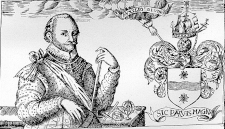 Sir Francis Drake with his new heraldic achievement, with motto: Sic Parvis Magna, translated literally: "Thus great things from small things (come)". The hand out of the clouds is labelled Auxilio Divino, or "With Divine Help"[76]
Sir Francis Drake with his new heraldic achievement, with motto: Sic Parvis Magna, translated literally: "Thus great things from small things (come)". The hand out of the clouds is labelled Auxilio Divino, or "With Divine Help"[76]
Purchase of Buckland Abbey

In 1580, Drake purchased Buckland Abbey, a large manor house near Yelverton in Devon, via intermediaries from Sir Richard Greynvile. He lived there for fifteen years, until his final voyage, and it remained in his family for several generations. Buckland Abbey is now in the care of the National Trust and a number of mementos of his life are displayed there.
Political career
Drake was politically astute, and although known for his private and military endeavours, he was an influential figure in politics during the time he spent in Britain. Often abroad, there is little evidence to suggest he was active in Westminster, despite being a member of parliament on three occasions.
After returning from his voyage of circumnavigation, Drake became the Mayor of Plymouth, in September 1581.[15] He became a member of parliament during a session of the 4th Parliament of Elizabeth I,[79] on 16 January 1581, for the constituency of Camelford. He did not actively participate at this point, and on 17 February 1581 he was granted leave of absence "for certain his necessary business in the service of her Majesty".[80]
Drake became a member of parliament again in 1584 for Bossiney[15] on the forming of the 5th Parliament of Elizabeth I.[81] He served the duration of the parliament and was active in issues regarding the navy, fishing, early American colonisation, and issues related chiefly to Devon. He spent the time covered by the next two parliamentary terms engaged in other duties and an expedition to Portugal.[80] He became a member of parliament for Plymouth in 1593.[80] He was active in issues of interest to Plymouth as a whole, but also to emphasise defence against the Spanish.[82][80]
Great Expedition to America

War had already been declared by Phillip II after the Treaty of Nonsuch, so the Queen through Francis Walsingham ordered Sir Francis Drake to lead an expedition to attack the Spanish colonies in a kind of preemptive strike. An expedition left Plymouth in September 1585 with Drake in command of twenty-one ships with 1,800 soldiers under Christopher Carleill. He first attacked Vigo in Spain and held the place for two weeks ransoming supplies. He then plundered Santiago in the Cape Verde islands after which the fleet then sailed across the Atlantic, sacked the port of Santo Domingo, and captured the city of Cartagena de Indias in present-day Colombia. At Cartagena, Drake released one hundred Turks held as slaves.[83] On 6 June 1586, during the return leg of the voyage, he raided the Spanish fort of San Agustín in Spanish Florida.[84]
After the raids he then went on to find Sir Walter Raleigh's settlement much further north at Roanoke which he replenished and also took back with him all of the original colonists before Sir Richard Greynvile arrived with supplies and more colonists. He finally reached England on 22 July, when he sailed into Portsmouth, England to a hero's welcome.[84]
Spanish Armada
Angered by these acts, Philip II ordered a planned invasion of England.
Cádiz raid
On 15 March 1587, Drake accepted a new commission with several purposes: disrupt the shipping routes to slow supplies from Italy and Andalucia to Lisbon, to trouble enemy fleets that were in their own ports, and to capture Spanish ships laden with treasure. Drake was also to confront and attack the Armada had it already sailed for England.[85] When arriving at Cadiz on 19 April, Drake found the harbour packed with ships and supplies as the Armada was readying and waiting for fair wind to launch the fleet to attack.[86] In the early hours of the next day, Drake pressed his attack into the inner harbour and inflicted heavy damage.[87] Claims of the Spanish ship losses vary. Drake claimed he had sunk 39 ships, but other contemporary sources are lower, specifically some Spanish sources which suggest losses as low as 25 ships.[88] The attack became known as the “singeing of the King’s beard” and delayed the Spanish invasion by a year.[89]
Over the next month, Drake patrolled the Iberian coasts between Lisbon and Cape St. Vincent, intercepting and destroying ships on the Spanish supply lines. Drake estimated that he captured around 1600–1700 tons of barrel staves, enough to make 25,000 to 30,000 barrels (4,800 m3) for containing provisions.[90]
Defeat of the Spanish Armada
Drake was vice admiral in command of the English fleet (under Lord Howard of Effingham,) when it overcame the Spanish Armada that was attempting to invade England in 1588. As the English fleet pursued the Armada up the English Channel in closing darkness, Drake broke off and captured the Spanish galleon Nuestra Señora del Rosario, along with Admiral Pedro de Valdés and all his crew. The Spanish ship was known to be carrying substantial funds to pay the Spanish Army in the Low Countries. Drake's ship had been leading the English pursuit of the Armada by means of a lantern. By extinguishing this for the capture, Drake put the fleet into disarray overnight.
On the night of 29 July, along with Howard, Drake organised fire-ships, causing the majority of the Spanish captains to break formation and sail out of Calais into the open sea. The next day, Drake was present at the Battle of Gravelines. He wrote as follows to Admiral Henry Seymour after coming upon part of the Spanish Armada, whilst aboard Revenge on 31 July 1588 (21 July 1588 OS):[91]
Coming up to them, there has passed some common shot between some of our fleet and some of them; and as far as we perceive, they are determined to sell their lives with blows.
The most famous (but probably apocryphal) anecdote about Drake relates that, prior to the battle, he was playing a game of bowls on Plymouth Hoe. On being warned of the approach of the Spanish fleet, Drake is said to have remarked that there was plenty of time to finish the game and still beat the Spaniards, perhaps because he was waiting for high tide. There is no known eyewitness account of this incident and the earliest retelling of it was printed 37 years later.[48] Adverse winds and currents caused some delay in the launching of the English fleet as the Spanish drew nearer,[48] perhaps prompting a popular myth of Drake's cavalier attitude to the Spanish threat. It might also have been later ascribed to the stoic attribute of British culture.
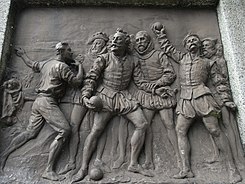 Sir Francis Drake whilst playing bowls on Plymouth Hoe is informed of the approach of the Spanish Armada. Bronze plaque by Joseph Boehm, 1883, base of Drake statue, Tavistock
Sir Francis Drake whilst playing bowls on Plymouth Hoe is informed of the approach of the Spanish Armada. Bronze plaque by Joseph Boehm, 1883, base of Drake statue, Tavistock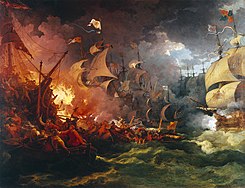 Eighteenth century portrait of the Spanish Armada by Philip James de Loutherbourg
Eighteenth century portrait of the Spanish Armada by Philip James de Loutherbourg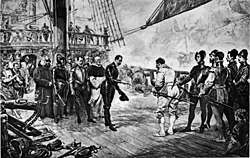 Drake taking the surrender of Admiral Pedro de Valdés on the Spanish galleon Nuestra Señora del Rosario
Drake taking the surrender of Admiral Pedro de Valdés on the Spanish galleon Nuestra Señora del Rosario
Drake–Norris Expedition
— Gonzalo González del Castillo, letter to King Philip II, 1592[92]
In 1589, the year after defeating the Armada the English sent their own to attack Spain, Drake and Sir John Norreys were given three tasks: seek out and destroy the remaining ships, support the rebels in Lisbon, Portugal against King Philip II (then king of Spain and Portugal), and take the Azores if possible. In the Siege of Coruña Drake and Norreys destroyed a few ships in the harbour of A Coruña in Spain but lost more than 12,000 lives and 20 ships. This defeat in all fronts delayed Drake, and he was forced to forgo hunting the rest of the surviving ships and head on to Lisbon.[90]
Defeats and death
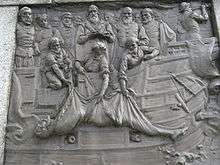
Drake's seafaring career continued into his mid-fifties. In 1595, he failed to conquer the port of Las Palmas, and following a disastrous campaign against Spanish America, where he suffered a number of defeats, he unsuccessfully attacked San Juan de Puerto Rico, eventually losing the Battle of San Juan.
The Spanish gunners from El Morro Castle shot a cannonball through the cabin of Drake's flagship, but he survived. He attempted to attack over land in an effort to capture the rich port of Panamá but was defeated again. A few weeks later, on 28 January 1596, he died (aged about 56) of dysentery, a common disease in the tropics at the time, while anchored off the coast of Portobelo where some Spanish treasure ships had sought shelter.[93] Following his death, the English fleet withdrew.[94]
Before dying, he asked to be dressed in his full armour. He was buried at sea in a sealed lead-lined coffin, near Portobelo, a few miles off the coastline. It is supposed that his final resting place is near the wrecks of two British ships, the Elizabeth and the Delight, scuttled in Portobelo Bay. Divers continue to search for the coffin.[95][96] Drake's body has never been recovered.
Cultural impact
In Valparaíso, Chile, folklore associates a cave known as Cueva del Pirata (lit. "Cave of the Pirate") with Francis Drake. A legend says that when Drake sacked the port he became disappointed over the scant plunder. Drake proceeded to enter the churches in fury to sack them and urinate on the goblets.[97] However he still found the plunder to be not worth enough to take it on board his galleon, hiding it in the cave.[97] Another version the legend says a treasure was left in the cave because the plunder had been more than he could take on board.[97] Together with the treasure Drake would have left a man chained or a sentry to wait for them to return, which they did not.[97] The treasure is said to still be there, but those who approach it drown.[97]
Further north in Chile a tale says that because Drake feared falling prisoner to the Spanish he buried his treasure near Arica, these being one of many Chilean stories about entierros ("burrowings").[97]
In the UK there are various places named after him, especially in Plymouth, Devon. Places there carrying his name include the naval base HMS Drake, Drake's Island, and a shopping centre and roundabout named Drake Circus. Plymouth Hoe is also home to a statue of Drake.
In the United States Drakes Bay and Sir Francis Drake Boulevard of Marin County, California are both named after him, as well as the high school in San Anselmo, California. The boulevard runs between Drakes Bay at Point Reyes to Point San Quentin on San Francisco Bay. There is a recent local movement to rename the boulevard and the high school because of Drake’s slave trader past.[98] A large hotel in Union Square, San Francisco also bears his name. Additionally, the Sir Francis Drake Channel in the British Virgin Islands bears his name.
In British Columbia, Canada, where some theorise he may also have landed to the north of the usual site considered to be Nova Albion, various mountains were named in the 1930s for him, or in connection with Elizabeth I or other figures of that era, including Mount Sir Francis Drake, Mount Queen Bess, and the Golden Hinde, the highest mountain on Vancouver Island.
Drake's will was the focus of a vast confidence scheme which Oscar Hartzell perpetrated in the 1920s and 1930s. He convinced thousands of people, mostly in the American Midwest, that Drake's fortune was being held by the British government, and had compounded to a huge amount. If their last name was Drake they might be eligible for a share if they paid Hartzell to be their agent. The swindle continued until a copy of Drake's will was brought to Hartzell's mail fraud trial and he was convicted and imprisoned.[99]
Drake's Drum has become an icon of English folklore with its variation of the classic King asleep in mountain story motif.
Drake was a major focus in the video game series Uncharted, specifically its first and third instalments, Uncharted: Drake's Fortune and Uncharted 3: Drake's Deception, respectively. The protagonist Nathan Drake claims to be a descendant of the explorer until the truth is revealed in the third game that Nathan changed his actual last name to Drake for unknown reasons, which is revealed in Uncharted 4: A Thief's End where Nathan and his brother Samuel changed their last name from Morgan to Drake in an attempt to honor their deceased mother's theory that Drake had heirs and also to start new lives as explorers and treasure hunters after they are forced to go on the run.
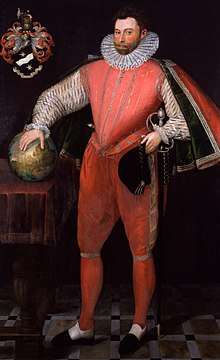 This portrait, circa 1581, may have been copied from Hilliard's miniature—note the similar shirt—and the somewhat oddly-proportioned body, added by an artist who did not have access to Drake. National Portrait Gallery, London.
This portrait, circa 1581, may have been copied from Hilliard's miniature—note the similar shirt—and the somewhat oddly-proportioned body, added by an artist who did not have access to Drake. National Portrait Gallery, London.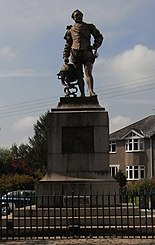 Bronze statue in Tavistock, in the parish of which he was born, by Joseph Boehm, 1883.
Bronze statue in Tavistock, in the parish of which he was born, by Joseph Boehm, 1883.- Drake Jewel, on loan at the Victoria and Albert Museum, London
See also
- Drake in California
- Drake's Leat, a water supply for Plymouth, promoted by Drake
- Francis William Drake, relative of Sir Francis Drake
- Giovanni Battista Boazio, Drake's mapmaker
References
- Federal Reserve Bank of Minneapolis. "Consumer Price Index (estimate) 1800–". Retrieved 1 January 2020.
- Woolsey, Matt (19 September 2008). "Top-Earning Pirates". Forbes.com. Forbes Magazine. Retrieved 5 February 2013.
- Paris Profiles. Bibliothéque Nationale, Paris. pp. Portfolio 17.
- Helen Wallis (1984). "The Catography of Drake's Voyage". In Norman J. W. Thrower (ed.). Sir Francis Drake and the Famous Voyage, 1577–1580: Essays Commemorating the Quadricentennial of Drake's Circumnavigation of the Earth. University of California Press. p. 143. ISBN 978-0-520-04876-8.
- Soto Rodríguez, José Antonio (2006). "La defensa hispana del Reino de Chile" (PDF). Tiempo y Espacio (in Spanish). 16. Retrieved 30 January 2016.
- According to the English calendar then in use, Drake's date of death was 28 January 1595, as the new year began on 25 March.
- His name in Latinised form was Franciscus Draco ("Francis the Dragon"). See Theodor de Bry.
- John Cummins (1997). Francis Drake: The Lives of a Hero. St. Martin's Press. p. 126. ISBN 978-0-312-16365-5.
- Mark G. Hanna (22 October 2015). Pirate Nests and the Rise of the British Empire, 1570-1740. UNC Press Books. p. 46. ISBN 978-1-4696-1795-4.
- Bland, Archie (10 June 2020). "After Colston, figures such as Drake and Peel could be next". The Guardian. Retrieved 14 June 2020.
- Andrews, Evan. "10 Things You May Not Know About Francis Drake". History. Retrieved 14 June 2020.
- Campbell, John (1841). Lives of the British Admirals and Naval History of Great Britain from the Time of Caesar to the Chinese War of 1841 Chiefly Abridged from the work of Dr. John Campbell. Glasgow: Richard Griffin & Co. p. 104. ISBN 9780665347566. OCLC 12129656. Retrieved 30 August 2012. Direct quote is followed by "this carries back his birth to 1544, at which time the six articles were in force, and Francis Russell was seventeen years of age."
- 1921/22 edition of the Dictionary of National Biography, which quotes Barrow's Life of Drake (1843) p. 5.
- Fuller-Elliot-Drake, Elisabeth (1911). The Family and Heirs of Sir Francis Drake. London: Smith, Elder & co. pp. 2, 21–22.
- Thomson, George Malcolm (1972), 'Sir Francis Drake', William Morrow & Company Inc. ISBN 978-0-436-52049-5
- "Francis Drake bio". Tudor Place. Retrieved 25 February 2010.
- Froude, James Anthony (1896). English Seamen in the Sixteenth Century. New York: Charles Scribner's Sons. Quote: "He told Camden that he was of mean extraction. He meant merely that he was proud of his parents and made no idle pretensions to noble birth. His father was a tenant of the Earl of Bedford, and must have stood well with him, for Francis Russell, the heir of the earldom, was the boy's godfather."
- Southey, Robert (1897). English Seamen: Howard, Clifford, Hawkins, Drake, Cavendish. London: Methuen and Co.
- Warren, Derrick (2005). Curious Somerset. Stroud: Sutton Publishing. pp. 90–91. ISBN 978-0-7509-4057-3.
- "The Occupants of the ancient office of High Sheriff of Somerset". Tudor Court. Retrieved 30 March 2011.
- "Captain Sir Francis DRAKE". tudorplace.com.ar. Retrieved 28 May 2008.
- Sugden, John (2006). Sir Francis Drake. Plimico. pp. 8–9.
- name="James Mill">James Mill (1840). The History of British India, Volume 1. London: James Madden and Co. p. 9.
- James Mill (1840). The History of British India, Volume 1. London: James Madden and Co. p. 9.
- Sugden, John (2006). Sir Francis Drake. Plimico. p. 9.
- Sources vary on the dates and the age of Drake.
- Carl Ortwin Sauer (1975). Sixteenth Century North America: The Land and the People as Seen by the Europeans. University of California Press. p. 235. ISBN 978-0-520-02777-0.
- Sugden, John (2006). Sir Francis Drake. Plimico. pp. 19–22.
- Benezet, Anthony (1788). Some historical account of Guinea, : its situation, produce, and the general disposition of its inhabitants, with an inquiry into the rise and progress of the slave trade, its nature and lamentable effects. London: J. Phillips.
- "History of English Slave Trade". Ehr.oxfordjournals.org. doi:10.1093/ehr/cej026. Retrieved 25 February 2010.
- Vicary, Tim. "Sir Francis Drake and the African Slaves". English Historical Fiction Authors. Retrieved 17 March 2018.
- "England's first slave trader". BBC. Retrieved 17 March 2018.
- "Drake escaped during the attack and returned to England in command of a small vessel, the Judith, with an even greater determination to have his revenge upon Spain and the Spanish king, Philip II."—"Sir Francis Drake" article in online Britannica Library. Retrieved 14 January 2016
- Kaufmann, Miranda. "The Untold Story of How an Escaped Slave Helped Sir Francis Drake Circumnavigate the Globe". History. Retrieved 12 May 2020.
- David Marley (2008). Wars of the Americas: A Chronology of Armed Conflict in the Western Hemisphere, 1492 to the Present. ABC-CLIO. pp. 103–104. ISBN 978-1-59884-100-8.
- Angus Konstam (20 December 2011). The Great Expedition: Sir Francis Drake on the Spanish Main 1585–86. Bloomsbury Publishing. p. 29. ISBN 978-1-78096-233-7.
- Cummins 1997, p. 287
- Cummins 1997, p. 273
- Sugden, John (1990). Sir Francis Drake. Barrie & Jenkins.ISBN 9780712620383; Great Britain. Public Record Office, Calendar of State Papers Relating to Ireland, of the Reigns of Henry VIII, Edward VI, Mary, and Elizabeth: Preserved in the State Paper Department of Her Majesty's Public Record Office, 11 vols (London: Longman, Green, Longman & Roberts, 1860–1912))
- Forde, Hugh (1923). Sketches Of Olden Days in Northern Ireland: Including Portrush, Dunluce Castle, Dunseverick Castle, Ballycastle, Giant's Causeway, Rathlin Island, Coleraine, Derry, Inishowen, Tory Island. Belfast: MC'aw, Stevenson and Orr Ltd.
- Sugden 2012, p. 130
- Kelsey 2000, p. 104
- Coote, p.133
- Barrow, John (1843). The Life, Voyages, and Exploits of Admiral Sir Francis Drake. J. Murray. p. 102. Retrieved 20 June 2020.
- Wagner, Henry R., Sir Francis Drake's Voyage Around the World: Its Aims and Achievements, Kessinger Publishing, LLC, 2006, ISBN 1-4286-2255-1.
- Martinic, Mateo (1977). Historia del Estrecho de Magallanes (in Spanish). Santiago: Andrés Bello. pp. 67–68.
- Martinic B., Mateo (2019). "Entre el mito y la realidad. La situación de la misteriosa Isla Elizabeth de Francis Drake" [Between myth and reality. The situation of the mysterious Elizabeth Island of Francis Drake]. Magallania (in Spanish). 47 (1). doi:10.4067/S0718-22442019000100005. Retrieved 21 December 2019.
- Kelsey, Harry, Sir Francis Drake; The Queen's Pirate, Yale University Press, New Haven, 1998, ISBN 0-300-07182-5.
- Cortés Olivares, Hernán F. (2005). "El origen, producción y comercio del pisco chileno, 1546–1931". Universum (in Spanish). Scielo.cl. 2 (20): 42–81. doi:10.4067/S0718-23762005000200005. Retrieved 25 October 2012.
- Davis, Loren; et al. (November 2013), "Inventory and Analysis of Coastal and Submerged Archaeological Site Occurrence on the Pacific Outer Continental Shelf", U.S. Department of the Interior, Bureau of Ocean Energy Management: 188
- Sugden, John (2006). Sir Francis Drake. London: Pimlico. p. 188. ISBN 978-1-844-13762-6.
- Gough, Barry (1980). Distant Dominion: Britain and the Northwest Coast of North America, 1579-1809. Vancouver: U Univ. of British Columbia Press. p. 15. ISBN 0-7748-0113-1.
- Von der Porten, Edward (January 1975). "Drake's First Landfall". Pacific Discovery, California Academy of Sciences. 28: 28–30.
- Morison, Samuel Eliot (1978). The Great Explorere: The European Discovery of America. New York: Oxford University Press, Inc. p. 700. ISBN 978-0195042221.
- Cassels, Sir Simon (August 2003). "Where Did Drake Careen The Golden Hind in June/July 1579? A Mariner's Assessment". The Mariner's Mirror. 89 (1): 263.
- Gough, Barry (1980). Distant Dominion: Britain and the Northwest Coast of North America, 1579-1809. Vancouver: U Univ. of British Columbia Press. p. 15. ISBN 0-7748-0113-1.
- Turner, Michael (2006). In Drake's Wake Volume 2 The World Voyage. United Kingdom: Paul Mould Publishing. p. 163. ISBN 978-1-904959-28-1.
- Cassels, Sir Simon (August 2003). "Where Did Drake Careen The Golden Hind in June/July 1579? A Mariner's Assessment". The Mariner's Mirror. 89 (1): 263,264.
- Gough, Barry (1980). Distant Dominion: Britain and the Northwest Coast of North America, 1579-1809. Vancouver: U Univ. of British Columbia Press. p. 15. ISBN 0-7748-0113-1.
- Sugden, John (2006). Sir Francis Drake. London: Pimlico. p. 136,137. ISBN 978-1-844-13762-6.
- Turner, Michael (2006). In Drake's Wake Volume 2 The World Voyage. United Kingdom: Paul Mould Publishing. p. 173. ISBN 978-1-904959-28-1.
- Sugden, John (2006). Sir Francis Drake. London: Pimlico. p. 135. ISBN 978-1-844-13762-6.
- Turner, Michael (2006). In Drake's Wake Volume 2 The World Voyage. United Kingdom: Paul Mould Publishing. p. 180. ISBN 978-1-904959-28-1.
- Morison, Samuel Eliot (1978). The Great Explorere: The European Discovery of America. New York: Oxford University Press, Inc. p. 702. ISBN 978-0195042221.
- Torben, Rick; et al. (December 2019). "Seventy Years of Archaeologial Research on California's Farallon Islands". California Archaeology. 11 (2): 184.
- Turner, Michael (2006). In Drake's Wake Volume 2 The World Voyage. United Kingdom: Paul Mould Publishing. p. 183,184. ISBN 978-1-904959-28-1.
- Prince's Worthies, op.cit.
- "The Drake Jewel". Oieahc.wm.edu. Retrieved 25 February 2010.
- Cummins 1997, p. 127
- Moseley, Brian (26 February 2011) [11 March 2004]. "Sir Francis Drake (c1541-1596)". The Encyclopaedia of Plymouth History. Plymouthdata.info. Archived from the original on 1 April 2012. Retrieved 12 February 2015.
- Hazard, Mary E. (August 2000). Elizabethan silent language. U of Nebraska Press. p. 251. ISBN 978-0-8032-2397-4.
- Perry, Maria (1990). The Word of a Prince: A Life of Elizabeth I from Contemporary Documents. Boydell Press. p. 182. ISBN 978-0-85115-633-0.
- Vivian, Lt.Col. J.L., (Ed.) The Visitations of the County of Devon: Comprising the Heralds' Visitations of 1531, 1564 & 1620, Exeter, 1895, p.292, pedigree of Drake of Ash
- Prince, John (1810) [1701]. Danmonii orientales illustres: or, The worthies of Devon. p. 329.
- Campbell, John (1828). The life of the celebrated Sir Francis Drake, the first english Circumnavigator: reprinted from The Biographia Britannica. London: Longman, Rees, Orme, Brown and Green. pp. 50–52. Retrieved 18 January 2013.CS1 maint: ref=harv (link)
- "Image details". National Trust Images. Retrieved 25 October 2012.
- Drake, Charles E.F., The Arms of Sir Francis Drake Archived 19 May 2012 at the Wayback Machine, Quebec, 2008; Article by str8thinker, Project Avalon Forum, Dec 2010, based on article of Charles Drake, 2008, op. cit.
- Vivian, p.299, pedigree of Drake of Crowndale and Buckland Abbey
- "1572". History of Parliament. Retrieved 28 July 2017.
- Hasler, P W. "DRAKE, Francis". History of Parliament. The History of Parliament Trust. Retrieved 28 July 2017.
- "1584". History of Parliament. Retrieved 28 July 2017.
- Andrews, Evan (4 April 2016). "10 Things You May Not Know About Francis Drake". History. Retrieved 28 July 2017.
- Kaufmann, Miranda (2017). Black Tudors: The Untold Story. London: Oneworld Publications. p. 160.
- Sugden p.189-90
- Sugden, John (2006). Sir Francis Drake. London: Pimlico. p. 205. ISBN 978-1-844-13762-6.
- Sugden, John (2006). Sir Francis Drake. London: Pimlico. p. 208. ISBN 978-1-844-13762-6.
- Sugden, John (2006). Sir Francis Drake. London: Pimlico. p. 209. ISBN 978-1-844-13762-6.
- Sugden, John (2006). Sir Francis Drake. London: Pimlico. p. 210. ISBN 978-1-844-13762-6.
- Thompson, Edith (1873). Freeman, Edward Augustus (ed.). History of England. Freeman's Historical Course for Schools. New York: Henry Holt and Company. p. 136.
- "Kraus, Hans. Sir Francis Drake: A Pictorial Biography, 1970". Loc.gov. 13 October 2005. Retrieved 25 February 2010.
- Letter to Admiral Henry Seymour written aboard Revenge on 31 July 1588 (21 July 1588 OS) Turner, Sharon. The History of England from the Earliest Period to the Death of Elizabeth, 1835.
- Cummins 1997, p. 5
- "The Last Voyage of Sir Francis Drake". loc.gov. p. 588. Retrieved 7 July 2020.
- "Sir Francis Drake". thepirateking.com. Retrieved 28 July 2017.
- "Sir Francis Drake's body 'close to being found off Panama'". BBC News. Retrieved 9 October 2013.
- Henderson, Barney; Swaine, Jon (24 October 2011). "Sir Francis Drake's final fleet 'discovered off the coast of Panama'". The Daily Telegraph. Retrieved 28 July 2017.
- Montecino Aguirre, Sonia (2015). Mitos de Chile: Enciclopedia de seres, apariciones y encantos (in Spanish). Catalonia. pp. 196–197, 269. ISBN 978-956-324-375-8.
- "Marin petition: Remove Drake sculpture, rename boulevard". Marin Independent Journal. 15 June 2020. Retrieved 16 June 2020.
- Rayner, Richard (22 April 2002). "The Admiral and the Con Man". The New Yorker. p. 150.
Bibliography
- Barrow, John (1843). The life, voyages, and exploits of Admiral Sir Francis Drake : with numerous original letters from him and the Lord High Admiral to the Queen and great officers of state. London: John Murray.
- Bawlf, Samuel (2003). The Secret Voyage of Sir Francis Drake, 1577–1580. Walker & Company. ISBN 0-8027-1405-6.
- Childs, David (2009). Tudor Sea Power: The Foundation of Greatness. Seaforth Publishing. ISBN 9781848320314.CS1 maint: ref=harv (link)
- Coote, Stephen (2005). Drake: The Life and Legend of an Elizabethan Hero. New York: Thomas Dunne Books. ISBN 9780743468701.CS1 maint: ref=harv (link)
- Corbett, Julian Stafford (1890). Sir Francis Drake.
- Hughes-Hallett, Lucy (2004). Heroes: A History of Hero Worship. Alfred A. Knopf, New York. ISBN 1-4000-4399-9.
- Kelsey, Harry (2000). Sir Francis Drake: The Queen's Pirate. Yale University Press. ISBN 9780300084634.CS1 maint: ref=harv (link)
- Kelsey, Harry (2004). "Drake, Sir Francis (1540–1596)". Oxford Dictionary of National Biography. Oxford University Press. doi:10.1093/ref:odnb/8022. Retrieved 20 May 2011. (subscription or UK public library membership required)
- Mattingly, Garett (1959). The Defeat of the Spanish Armada. ISBN 0-395-08366-4. A detailed account of the defeat of the Spanish Armada which received a special citation from the Pulitzer Prize committee in 1960.
- Merideth, Mrs Charles, Notes and Sketches of New South Wales, during a residence in that colony from 1839 to 1844; Bound With: "Life of Drake" by John Barrow (1st ed., 1844) [xi, 164; and xii, 187 pp. respectively]
- Hakluyt, Richard (1880). Payne, Edward John (ed.). Voyages of the Elizabethan seamen to America. Thirteen original narratives from the collection of Hakluyt. London: Thos. de la Rue & Co.
- Rodger, N. A. M. (1997). The Safeguard of the Sea: A Naval History of Britain 660–1649. London
- Sugden, John (2012). Sir Francis Drake. Random House. ISBN 9781448129508.CS1 maint: ref=harv (link)
- Wilson, Derek (1977). The World Encompassed: Drake's Great Voyage, 1577–80. Harper & Row. ISBN 0-06-014679-6.
External links
| Wikimedia Commons has media related to Francis Drake. |
| Wikisource has the text of a 1920 Encyclopedia Americana article about Francis Drake. |
| Wikiquote has quotations related to: Francis Drake |
- Francis Drake at Spartacus Educational
- Hand-coloured map depicting Sir Francis Drake's attack on Saint Augustine from the State Archives of Florida
- Kraus Collection of Sir Francis Drake From the Rare Book and Special Collections Division at the Library of Congress
- Sir Francis Drake: A Pictorial Biography by Hans P. Kraus From the Rare Book and Special Collections Division at the Library of Congress
- Mission to rescue Drake's body
- Drake's methods of Navigation
- . New International Encyclopedia. 1905.

- England's first slave trader

